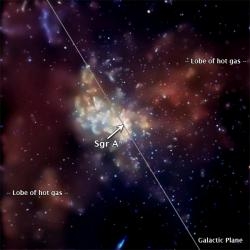Two egg-shaped necklaces of magnificent stars orbit the enormous black hole known as Sagittarius A* (Sgr A*) at the center of the Milky Way Galaxy. Sgr A* (shown right) has long been thought to be well past promoting new star formation; until the necklaces were discovered, the black hole was considered to be just an aging, depleted relic of its glory days of organizing the Galaxy.
What’s fascinating about the fiery necklaces is that they each contain a few thousand massive stars formed about 6 million years ago, all at about the same time, and pretty much where we see them now — within one-third of a lightyear of Sgr A*. Curiously, the two necklaces are angled with respect to one another, and consequently don’t interact much with each other.
Whatever process brought these rings of massive stars into existence may well be routine in the Universe, however. For instance, there is a similar cluster of coherent massive stars orbiting Andromeda’s central black hole. However routine their formation may have been, though, the dazzling young stars must have come into being quite differently from stars born in cold gas clouds elsewhere in the two galaxies.
Theorists Richard Alexander, a research associate, and Fellows Mitch Begelman and Phil Armitage are working together to model how two rings of massive stars at odd angles to each other formed simultaneously around a supermassive black hole. In the process, they must determine why the orbit of one stellar necklace is moderately elliptical and the other extremely so. The eccentricity of the orbits is somewhat puzzling because the researchers originally hypothesized that both started out circular.
The new model not only has to account for the orbital eccentricities, but must also explain why the necklaces contain so many more massive stars and so many fewer smaller stars than stars formed in a nebula such as Orion. Preliminary findings have indicated that the stellar necklaces were probably not captured from a nearby star cluster by Sgr A*. Rather, they suggest that one (or two) gaseous disk(s) in the process of being pulled into orbit around the black hole broke up into stars before the disks’ orbits ever became circular. The researchers are currently simulating how eccentric disks fragment into stars and determining what kinds of stars are produced by such a process. Eventually, they hope to model exactly how the massive stars were formed and how their orbits evolved into the pattern we observe today. - Julie Phillips



 The Physics Frontiers Centers (PFC) program supports university-based centers and institutes where the collective efforts of a larger group of individuals can enable transformational advances in the most promising research areas. The program is designed to foster major breakthroughs at the intellectual frontiers of physics by providing needed resources such as combinations of talents, skills, disciplines, and/or specialized infrastructure, not usually available to individual investigators or small groups, in an environment in which the collective efforts of the larger group can be shown to be seminal to promoting significant progress in the science and the education of students. PFCs also include creative, substantive activities aimed at enhancing education, broadening participation of traditionally underrepresented groups, and outreach to the scientific community and general public.
The Physics Frontiers Centers (PFC) program supports university-based centers and institutes where the collective efforts of a larger group of individuals can enable transformational advances in the most promising research areas. The program is designed to foster major breakthroughs at the intellectual frontiers of physics by providing needed resources such as combinations of talents, skills, disciplines, and/or specialized infrastructure, not usually available to individual investigators or small groups, in an environment in which the collective efforts of the larger group can be shown to be seminal to promoting significant progress in the science and the education of students. PFCs also include creative, substantive activities aimed at enhancing education, broadening participation of traditionally underrepresented groups, and outreach to the scientific community and general public.